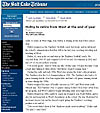|
 Dec.
16, 2006: The Salt Lake Tribune Dec.
16, 2006: The Salt Lake Tribune
Prep Wrestling: New Limit May Bring
More Kids to Mat
by Jay Drew
In a demanding and physically challenging
sport such as wrestling, high school coaches are
continually trying to drum up interest in their school's
hallways and classrooms to get more athletes on the mats.
Sure, there are powerhouses like Viewmont,
Wasatch and Millard that never seem to go wanting. But for
many teams throughout Utah, it is a struggle to fill all
14 weight divisions with quality wrestlers, especially at
the varsity level.
That's why most of the state's coaches
seem happy with this year's rule change that increases the
limit in the heavyweight division from 275 to 285 pounds,
even if the change has the potential to create a bigger
disparity for competitors.
"It is all about allowing kids to
participate. The more the better," new Brighton coach Wade
Brown said. "I think most [coaches] like it."
The change brings high schools in line
with college wrestling programs, where 285 has been the
limit for many years.
The division below heavyweight still has
215 pound limit, so the change means there could now be a
70-pound gap among the big boys. But at heavyweight,
winning is often more about technique and quickness than
sheer size, coaches say.
As an example, they point to Lone Peak's
Sterling Coons, who won the Class 5-A heavyweight title
last season despite weighing just 225 pounds. He routinely
beat wrestlers in the 250-275 range, thanks to superior
conditioning and technique.
Also, coaches say, athletes who weighed
between 216-230 pounds for football can get under 215
fairly easily, so the gap is more like 55 pounds.
Then again, that wasn't the case at the
Layton Invitational a few weeks ago, when Viewmont sent a
wrestler barely above 215 pounds, Jesse Farnsworth, into a
match against Fremont's JC Oram, who was right around 285.
"That weight division is an interesting
animal," Viewmont coach Bart Thompson said. "It brings
more kids into wrestling, so [the rule change] is a good
thing, but you are going to see even more [mismatches]
than you see now."
However, not all coaches favor the change.
West Jordan's Larry Jaramillo said he was "surprised" that
the change was implemented so quickly and has "serious
doubts" it will draw heavier boys into the sport.
"Either a kid is motivated to lose the
weight to get to 275, or he's not," Jaramillo said. "In
our school, I don't see it making a difference [in
participation]. Now, it is a pretty big spread of weight.
They should have distributed it a little better" by moving
the 215 division limit up a bit.
The rule change was one of 14 approved by
the National Federation of State High School Associations
for wrestling this season. This is the first increase in
weight limits since 1987.
"Wrestlers are bigger than they were 19
years ago," said Jerry Diehl, an NFHS assistant director
and wrestling rules committee liaison.
Thompson said before 1987, there was no
weight limit in the heavyweight division, and it was known
as the "unlimited" division.
"Now, that was a lot of disparity," he
said. "You would have 350-pound kids against 220-pound
kids."
Jerry Bovee, UHSAA assistant director,
said Utah generally stays in compliance with the national
organization's directives to stay in good graces with the
NFHS.
"I haven't heard any complaints about it,"
Bovee said. "A lot of coaches don't like the new body fat
testing rules [implemented last year], but that's a topic
for another time."
Other rule changes in wrestling this year
are fairly minor.
Overtimes will now be up to one minute
longer. If neither wrestler scores after the first
sudden-death overtime, there will be two 30-second
tiebreaker periods and, if the score is still tied, a
third 30-second tiebreaker will follow in which the first
wrestler to score wins.
If nobody scores, the more offensive
wrestler will be declared the winner.
Utah coaches like the overtime change
because it makes correctly calling the coin flip — which
determines who starts on top — less important.
|